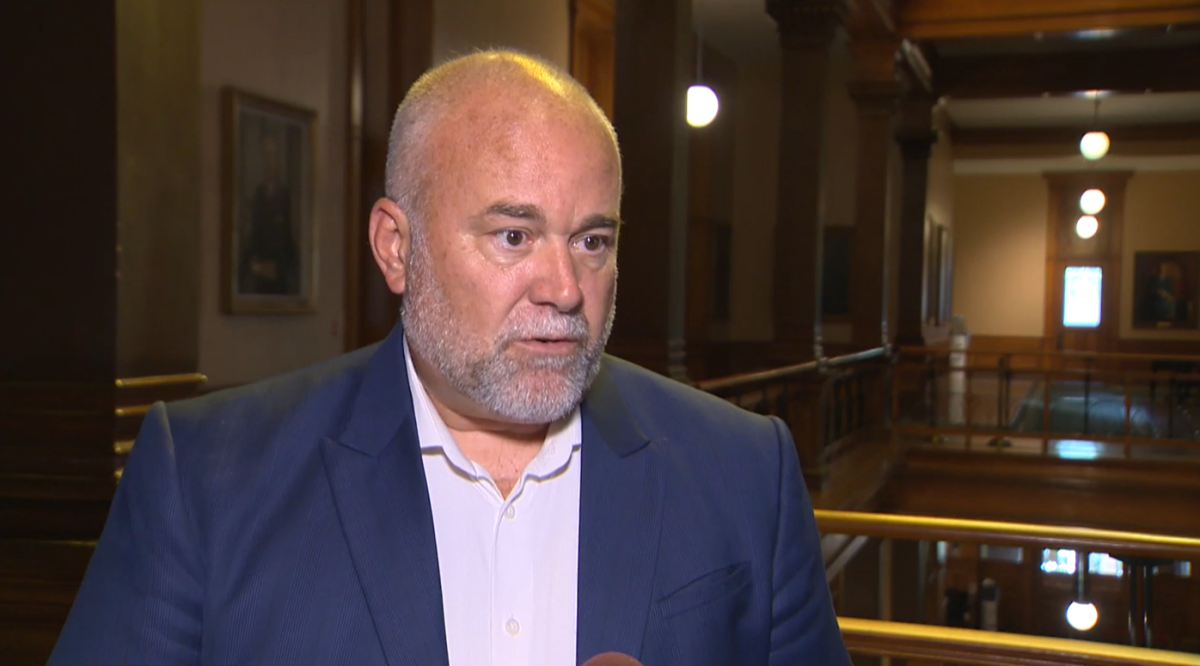“I believe in climate change,” Ontario Premier Doug Ford told reporters ahead of the 2022 general election. “And we’re doing everything to prevent it by building electric vehicles, having investment into the battery plants.”

Ford tacked his climate credentials to major spending promises for Ontario’s green economy.
Alongside Prime Minister Justin Trudeau, in the run-up to June’s election, he announced spending packages focused on electric vehicles, including in Alliston, Brampton and Windsor.
However, upcoming closures and renovations at Ontario nuclear power plants could reduce the environmental benefits of Ford’s plan.
A decrease in nuclear-generated electricity through the 2020s will see more natural gas — a fossil fuel — used to create electricity that will power zero-emissions buses and cars.
“Ontario had already made huge progress by getting rid of the coal plants (in 2014),” Tim Gray, executive director of Environmental Defence, told Global News. “The idea of shutting a nuclear reactor and building a fossil fuel plant is insane … it doesn’t make any sense at all.”
He suggested the province should instead focus its spending on renewable alternatives that are “emissions free and cheaper.”
One report by an Ontario crown corporation predicts the switch from nuclear to gas will see the province’s electric-generation emissions grow 177 per cent by 2030.
- Ontario takes action against chemical plant after Aamjiwnaang First Nation residents fell ill
- High benzene levels detected near Ontario First Nation for weeks, residents report sickness
- Enter at your own risk: New home security camera aims paintballs at intruders
- Beijing orders Apple to pull WhatsApp, Threads from its China app store
Over the next decade, one of the province’s nuclear power stations will close its doors for good, while others will undergo renovations and temporary shutdowns.
Todd Smith, Ontario Minister of Energy, told Global News his priority was ensuring Ontario had an electricity grid that is “stable, reliable, affordable and one that’s clean.”
Pressed on the increased reliance on gas — and its emissions — Smith said reliability was his top priority.
“We have to make sure that it’s affordable and we have to make sure that it’s reliable,” he said.
The Pickering Power Generation Station will be retired, beginning in 2024, under the current term of Ford’s re-elected PCs. Refurbishments will mean “long-term outages” at both Darlington and Bruce nuclear power stations.

The province “is moving forward with plans to build Canada’s first (Small Modular Reactor or ‘SMR’) at the Darlington site, pending regulatory approvals from the Canadian Nuclear Safety Commission.”
According to the Government of Ontario’s website, “SMRs are nuclear reactors that are significantly smaller and more flexible than conventional nuclear reactors.”
The Pickering plant was responsible for around 14 per cent of Ontario’s electricity last year.
“We pretty much need natural gas to make up for the shortfall, certainly in the medium-term,” Zeb Tate, associate professor in the department of electrical computer engineering at the University of Toronto, told Global News.
A quote from Smith, Minister of Energy, on the Ontario Power Generation (OPG)’s website describes nuclear power as “the backbone of Ontario’s clean electricity grid.”
Nuclear reactors are the joint-largest source of electricity in Ontario, according to Independent Electricity System Operator (IESO), the crown corporation responsible for the electric market.

A total of 26 per cent of installed capacity comes from nuclear, alongside 26 per cent from gas. Hydroelectric power accounts for 23 per cent, while wind and solar makeup 14 and seven per cent respectively.
IESO manages the electrical market in Ontario. It reduces and increases supply and negotiates contracts to generate electricity with third-party companies. It does not own any power generators itself.
To handle a significant loss of nuclear-generated energy, Ontario plans to open the gas taps and burn more fuel.
A recent study by IESO predicted “that without gas generation, Ontario’s electricity system would see frequent and sustained blackouts in 2030.”
That forecast was described as its “most optimistic assumptions.”
The electricity system operator said Ontario is already using hydro to its max, while solar and wind power rely on the weather.
Natural gas generation can provide the reliability and flexibility needed to support green initiatives and an ensuing increase in electricity demand, such as from electric vehicles and electric arc furnaces in steelmaking.
By around 2038, the IESO projects the net greenhouse gas emission reductions from electric vehicles will offset electricity sector emissions.
“An increase in electricity sector emissions does not necessarily mean an increase in economy-wide emissions,” the IESO report on natural gas says.

The switch to gas is a move Jack Gibbons, from the Ontario Clean Air Alliance, believes will be disastrous for Ontario’s emissions and attempts to reach net-zero.
“That’s absolutely the worst possible strategy, we need to reduce our greenhouse gas pollution, not increase it,” he told Global News. “We should instead be investing in the lower cost options: energy efficiency, renewables, buying low-cost Quebec water power.”
The Ontario Clean Air Alliance said the suggestion of blackouts with the phase-out of gas power is “fundamentally flawed and wrong.”
Gibbons said the group would encourage the government to keep gas-fired power stations on standby over the next 20 years as a backup, focusing spending on renewable energy sources.
The United States Energy Information Administration (EIA) describes natural gas as a “relatively clean” fossil fuel — but a fossil fuel nonetheless.
More than 30 municipalities across Ontario have passed motions calling on the province to wind down its use of natural gas power plants.
That request would be impossible to implement, IESO predicts.
“For the average homeowner, the effect of removing gas would add $100 to the monthly electricity bill, which represents a 60 per cent increase,” the Crown corporation’s report on the suggestion said.
As nuclear power wobbles in the 2020s, Ontario will move in the opposite direction and lean more heavily on gas. The switch comes as demand for electricity looks set to grow.
IESO expects demand to increase at an average of around 1.7 per cent every year as a result of growing demand from the agricultural sector, economic recovery following COVID-19, population growth and “an increasing focus on electrification.”
An increase in power generation will be needed to meet that demand, IESO says, “principally (using) gas generators.”
The reliance on gas power will see emissions rise from a recent average of 4.4 megatonnes to as much as 12.2 megatonnes in 2030.
While IESO points out that figure is one-third of Ontario’s 2005 emissions, it represents a 177 per cent increase compared to the grid’s recent carbon footprint.
How this impacts the PC Party’s electrification-focused promise of a greener economy remains to be seen.
“While some increases in greenhouse gas emissions intensity are forecast in the coming decade, Ontario’s grid will remain one of the cleanest in the world, and the benefits of electrifying transportation and other energy end uses will remain substantial,” a spokesperson for the Ontario Ministry of the Environment, Conservation and Parks said when asked for comment.

An example within IESO’s report on phasing out gas-generated electricity illustrates how much dirtier natural gas in the grid makes electric cars.
An electric car charged in Ontario using the 2021 grid composition produces just three per cent of the emissions a gas-powered car does, the report found.
However, on the hottest summer day — when gas is “used the most” to accommodate the increased demand for electricity created by air conditioning — an electric car would use 40 per cent of the emissions of a gas car.
That example still assumes Ontario’s nuclear power stations are operating at full-tilt.
IESO is working on a study considering how to green its emissions in the long run. The Crown corporation set to report back to him in November on the potential gas moratorium as well as a plan to get to zero emissions in the electricity sector.
“I think from the operator’s perspective, you’ve got to remember, their main concern is keeping the lights on,” associate professor Tate said.
“Natural gas — they know they can call someone and say, ‘Increase your power right now’ and it’ll happen within minutes. That’s very attractive thing to an operator who is responsible for making sure electricity is there.”
“They would, I think, favour reliability over greenhouse gas emissions.”
— with files from The Canadian Press






Comments